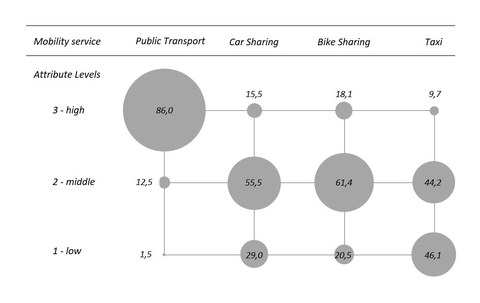May 25, 2021
Publication on the designing of mobility concepts for specific user groups

Acceptance of the respective characteristics of the mobility service in the mobility package in percent. The higher the attribute level, the greater the scope of use in the package.
How and for whom must mobility offers be designed in order to reach as many users as possible and thereby reduce the reliance on private vehicles? Which user groups of mobility offers can be identified and are there patterns that allow the offer to be reduced to a few product bundles?
These and other questions are discussed in the article “Conjoint analysis of mobility plans in the city of Dresden” by Benjamin Maas, a former researcher of the Chair of Industrial Management and the Center for Car Business Management, and his supervisor, Prof. Dr. Udo Buscher, which has now been published in the European Transport Research Review (https://doi.org/10.1186/s12544-021-00478-2). The contribution builds on the successful work of Cluster C of the Boysen-TU Dresden Research Training Group ("Electromobility and Autonomous Driving: Perspectives for Suppliers, Users and Media") and provides valuable starting points for the analysis of user behavior adjustments in the case of new mobility concepts in sub-project C3 "Analysis of User Behavior Adjustments for New Mobility Concepts”.
Bundled mobility offers that combine various services in one package form the basis of the study carried out: "Mobility as a Service". In order to cope with various routes, individual services no longer have to be planned, booked, and used, but a multitude of options are available as part of a package solution. How exactly these packages should be designed in order to achieve the greatest possible user acceptance was the subject of a user survey, in which a total of 321 respondents from the Dresden metropolitan area took part. By means of a conjoint analysis, different variants of mobility packages were presented and evaluated, which differed in the type and scope of the mobility services included. In this way, the preferences of users with regard to local public transport, car sharing, bike sharing, taxis, and the price of mobility could be examined.
While the great importance of local public transport and especially the monthly ticket for the acceptance of mobility packages is evident for all users, individual users differ with regard to the inclusion of other mobility alternatives in package offers. The clusters of mobility users identified in the sample provide clues for a user group-specific designs of offers in order to specifically address their needs and thus achieve a higher level of acceptance.
